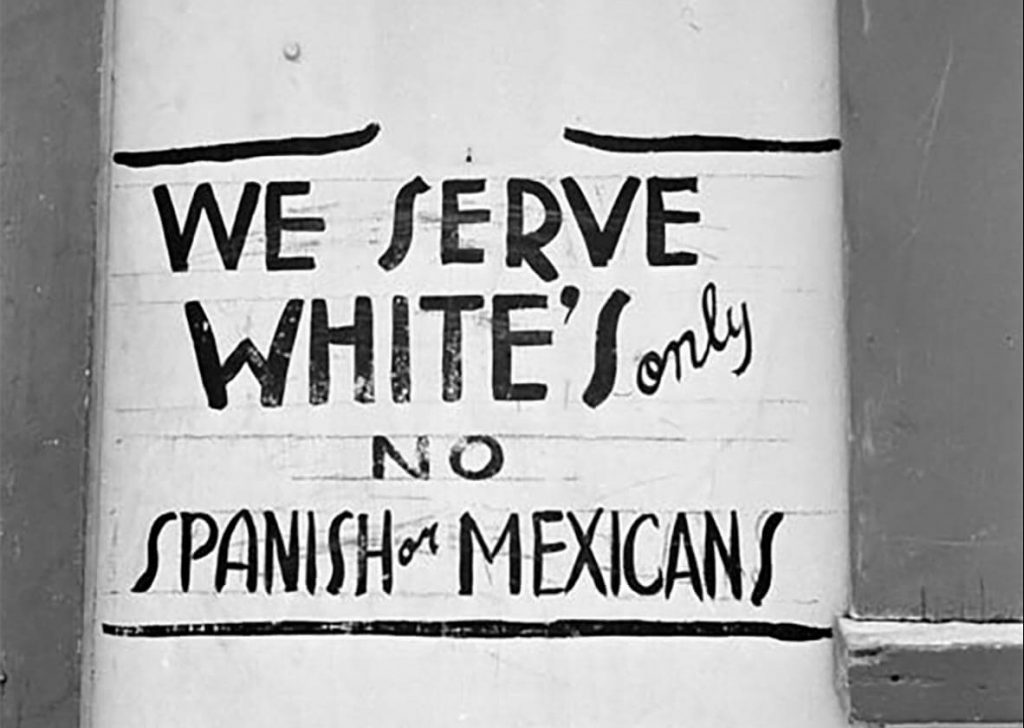1911, Antonio Gomez, a fourteen-year-old Mexican-American boy, was walking home carving pieces of wooden shingles, when suddenly a saloon owner shoved him to the street. Gomez was scolded by the saloon owner for littering on the sidewalk shouting, “the sidewalk is no wastebasket.” A group of men that was at the saloon cheered on the owner and cursed at Gomez. As the boy gathered his shingles and tried to leave, a man by the name of Charles Zieschang snatched the wooden shingles from the boy’s hand and told the owner he could, “make the damn little skunk quit whittling.” Zieschang whipped Antonio Gomez with his own wooden shingles while other men watched and ridiculed the boy. Out of self-defense Antonio Gomez stabbed Zieschang with the pocket knife he was using to carve the wooden shingles. Zieschang died from blood loss in twenty minutes.1

Mexican-Americans were somewhat immune to the racist Jim Crow policies of the south that made discrimination against black Americans legal. This was due to the fact that Mexicans were “white by law” since the signing of the Treaty of Guadalupe Hidalgo in 1848. So, the Juan Crow laws emerged as a way to legally discriminate against Mexican Americans. Through Juan Crow prejudices, Texas passed English-only laws that led to future segregation of Mexican-Americans in school systems. Anglos pushed for segregation of Mexican-Americans in school because they believed having their children learn alongside Mexican-American children would hinder them. Segregationists also believed that it was safer for their white children because they believed Mexican-Americans reached puberty earlier. Unsurprisingly the anti-Mexican efforts were blind-sided by authorities across the state giving more power to Juan crow laws that essentially justified discrimination and mistreatment of Mexican-Americans.2

Antonio Gomez was taken into custody almost immediately by constable McCoy and taken into the town jail of Thorndale, Texas. Soon after his arrest, another version of the altercation went around. Some were claiming that Gomez was the attacker who waited for Zieschang to come out of the saloon after having snatched his wooden shingle and peacefully retreating to the saloon. The people were so eager to bring their own “justice” that they were willing to act as witnesses without having seen anything. Although history has yet to prove which story is the most accurate, the only part that remains constant is the events that led up to his death. Gomez became an instant target for lynching because the citizens knew he was too young for capital punishment in the state of Texas, but they were willing to take matters into their own hands. It was reported that a mob of more than a hundred people waited for justice outside the jail. Constable McCoy who placed Gomez in jail tried to transfer him to another jail out of fear that the boy would be lynched by the people. The constable knew that the small jail could keep Antonio Gomez in, but he wasn’t sure that it could keep an angry mob out. Gomez was led through the back of the jail with a chain around his neck and straight to a house. McCoy went to look for reliable transportation to another jail while Gomez was kept in a safe place, or so he thought. Somehow the angry mob learned the location of Antonio Gomez and managed to steal him from authorities.3
Racism had grown its roots very deep and brutally here in the state of Texas. Racism in Texas stems back not only to slavery and the prejudice towards black people, but to native Americans as well. Mexicans were sometimes saved by the law which would recognize a Mexican person as “white” as long as their skin permitted it. If you were not of fair skin, then you risked being persecuted. Most Anglo-Americans had an “us versus them” mentality when it came to Mexican-Americans. This was because many Anglo-Americans picked up on American nationalism and nativism going against Mexican-Americans who were wrongly stereotyped. Mexican-Americans were usually seen as inferior, violent, and even anti-American. Racism against Mexican-Americans was like a double-edged sword. Mexican-Americans had to deal with Anglo-Americans who did not accept them and did not think they were American enough. Simultaneously, Mexican-Americans dealt with Mexicans who also thought less of Mexican-Americans, often times looking at them as traitors. Racism in the state of Texas was not only on the mere surface, but it had also been implemented systematically, from the school systems to the housing system and even the labor systems. This is because our country’s story is based on a consensus history, which means that our history is based on points of view that seeks to paint an exciting picture of our history, and downplaying the tragedies that occurred.4

Antonio Gomez was captured by an angry mob and was dragged by a horseman who managed to grab the chain that was around Gomez’s neck. Antonio Gomez’s body was found lifeless hanging from a telegraph pole next to a ladder. Only three hours had passed since the death of the man that Gomez was charged for “murdering.” The body of the child was found bruised up and beaten horribly with a chain around his neck. After beating the boy and dragging him, the men mercilessly suspended his body from the pole. Before the men managed to hang his body, they had a failed attempt where they dropped his body and kicked his head. The constable was too late when he arrived at the scene.5
How common were these anti-Mexican lynching’s? Although hateful crimes against Mexicans were common, it was not so common to be recorded for history. There are records to show that from 1848 to 1928 at least 597 deaths of Mexicans in Texas were due to mob violence or lynchings. These attacks directed towards Mexicans and Mexican-Americans were not only done by other citizens, but they were also planned systematically by Texas Rangers. Another example of brutal deaths by mob violence is the lynching and burning of Antonio Rodriguez. These acts of terror were very common in Texas, especially towards ethnic groups such as African Americans, Mexicans, and even native Americans even earlier.6

It is important to know the stories of such victims of racism and mob violence like that of Antonio Gomez or even of Jesse Washington. Although these stories are not the most appealing, it is important to recognize these people and their stories because it is our history whether we like it or not. It is important for all people to know the truth. Stories like these are even relevant today. We could look at recent laws such as SB4 that encouraged racism among law enforcement, or even the stereotypes that current president Trump has promoted. The story of Antonio Gomez shows just how far and systematic racism has been in our state of Texas or even in our country. It is important to know the entire truth of history, not just one point of view. Why haven’t you heard of Antonio Gomez? Why was Mexican-American studies just recently added to the Texas public school curriculum in 2014, and only as an elective? Why isn’t the history of Mexican people in our textbooks when it is a vital part of who we are and where we come from, especially here in Texas?
- Nicholas Villanueva,The Lynching of Mexicans in the Texas Borderlands (Albuquerque: University of New Mexico Press, 2017), 125; George T. Diaz, “A Review of the Lynching of Mexicans in the Texas Borderlands,” Southern Spaces, no. 1 (2018): https://southernspaces.org/2018/review-lynching-mexicans-texas-borderlands/ . ↵
- George T. Diaz, “A Review of the Lynching of Mexicans in the Texas Borderlands,” Southern Spaces, no. 1 (2018): https://southernspaces.org/2018/review-lynching-mexicans-texas-borderlands/. ↵
- Nicholas Villanueva,The Lynching of Mexicans in the Texas Borderlands (Albuquerque: University of New Mexico Press, 2017), 125. ↵
- Marlon Bishop and Julia Shu, “The History of Anti-Mexican Violence and Lynching” Latino USA, no. 1(2016): 1-2, https://www.latinousa.org/2016/03/11/the-history-of-anti-mexican-violence-and-lynching/; William D. Carrigan, Forgotten Dead: Mob Violence Against Mexicans in the United States (Oxford: Oxford University Press, 2013), 77. ↵
- Nicholas Villanueva,The Lynching of Mexicans in the Texas Borderlands (Albuquerque: University of New Mexico Press, 2017), 125, http://search.ebscohost.com/login.aspx?direct=true&db=nlebk&AN=1423320&site=eds-live&scope=site; George T. Diaz, “A Review of the Lynching of Mexicans in the Texas Borderlands,” Southern Spaces, no. 1 (2018): https://southernspaces.org/2018/review-lynching-mexicans-texas-borderlands/ . ↵
- William D. Carrigan, Forgotten Dead: Mob Violence Against Mexicans in the United States (Oxford: Oxford University Press, 2013), 77. ↵



58 comments
Julia Aleman
It’s tragic how many unspoken stories of racism there are about Mexicans and Mexican-Americans. This topic means a lot to me and my family because a few years ago my uncle made a documentary called ‘Stolen Education’ about my grandmother and others living in Driscoll, Texas. Back then in the schooling systems, they weren’t aloud to speak Spanish in the classrooms and were treated very poorly when all they wanted was to learn. I agree with this writing because there are so many stories like this that are hidden behind closed doors and not discussed enough in the classrooms.
Desiree Arizmendez
In high school, we never really focused on the history of mexican-americans so all of the information you presented at the beginning of the article was so new to me so the statement you made about the way history is taught really makes so much sense. I had never heard of it and it is so crazy to have heard about it. I did not know about the fact that Mexicans are white by law. It is crazy how injustices against Mexican Americans is not spoken about as much as other types of prejudices.
Kimberly Rubio
As a product of the Texas public school system, I remember learning about Jim Crow laws, the Civil Rights Movement, and Martin Luther King Jr.; however, I did not learn about Juan Crow laws until I reached adulthood. As a young student, I remember wondering where Mexican Americans stood with regard to segregation. It is unfortunate that stories like that of Antonio Gomez are not taught in all Texas classrooms. Though these are difficult stories to read about, it is necessary. I wonder how many more stories are not documented. Even this story has many versions, as you mentioned.
Maria Obregon
This article was very informative. I knew that Mexicans and Mexican-Americans were treated badly in the past, but this article taught me so much more. It is so unfair how Mexican-Americans did not only have to deal with Anglo-Americans treating them badly, but also Mexicans because they thought of them as “traitors.” Also, Antonio Gomez’s story was extremely heartbreaking to read. He was only a young boy. I do not understand, and will never understand, how people could ever do the things they did to hurt him and kill him. Antonio’s story deserves to be told and not forgotten, as well as the other people who went through the same, if not similar things.
Abilene Solano
I honestly have no words about this article (overall I’m shocked about the events that I have read). I knew that Mexican-Americans experienced racism but I didn’t know too much about it, like the author had mentioned, I didn’t learn about this at all when I was at school. I never heard of the “Juan Crow laws” or that Mexican-Americans were being discriminated against by both White people and Mexicans. I agree that schools should start talking about the shortcoming that this country faced because America is not picture perfect, no country really is so hiding the issues that rise up like discrimination or racism should be exposed not hidden.
Pedro Lugo Borges
Its sad when a child is killed no matter the circumstance is a terrible tragedy but being lynched for self defense especially in texas were self defense laws are numerous and active such as the stand your ground law, is just un imaginable. The fact that by law we were considered “white” but at the same time the. state was trying to finds legal ways for mexicans to be systematically discriminated by “juan crow” laws that i never have heard of ether. throughout my life i moved constantly from mexico to the usa because if complex family matters but i was never truly seen as mexican in mexico and over here until my later year in highschool i was always know as mexican. it horrible that there was another story of the events and peoples confirmation bias is what lead to the direct lynching of the child.
Yaniev Ibarra
What an eye opening article. I was always aware of the prejudice towards Mexican-Americans but this story really enlightened me more on the topic. Antonio Gomez was only 14 years old when he was lynched by a mad mob in a system that had Juan Crow Laws in place. Legally allowed to discriminate these minorities. I had no previous knowledge on the Juan Crow Laws, how people could discriminate Mexican-Americans and it was legally justified. By the end of this article I was already questioning many things about the school system, the laws in place, and the racial segregation. Poor Antonio, I hope his story is never forgotten.
Andres Garcia
Before reading this article, I was aware that many Mexican-Americans back then experienced racism from both Mexicans and people from the United States but I had never heard of Juan Crow laws or Mexican-Americans being lynched. I agree with your statement that history is taught in a way that only the accomplishments are taught while the country’s shortcomings are swept under the rug. Ironically, a lot of people say it is important to know our history to avoid making the same mistakes, yet countless mistakes are not taught.
Sophia Rodriguez
As a Mexican American I understand what it means to not be American enough and not me Mexican enough. I have always known that Mexican Americas have suffered, but I did not know they lynched a boy for something that was not even his fault. Texas has a dark history and I know there is still a town today that my father says to make sure not stop in because the people there may harass us. I really enjoyed this article because it makes us realize how a lot of Mexican American stories are not told and we have a hard background that we come from also.
Vianka Medina
As a Mexican-American, I had never heard of Juan Crow laws, that is crazy that it has never been brought up before! This article makes me want to do research and look more into discrimination against Mexican-Americans and other races that are not brought up as much. I agree with the idea that our own government does not talk about racism enough, or put it in textbooks teaching younger generations the real truth about the past. They are keeping untold stories that need to be heard, a secret. Thank you for this very informative article and bringing this topic to notice!